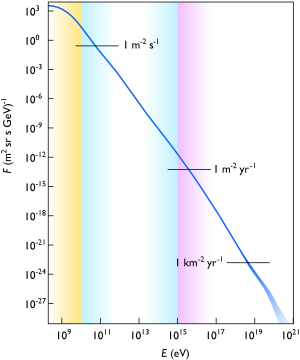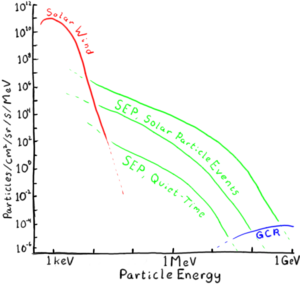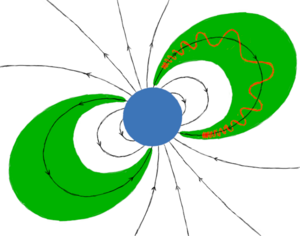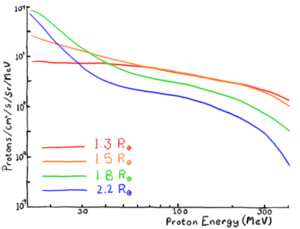Space Radiation: Difference between revisions
| Line 75: | Line 75: | ||
=== Earth === | === Earth === | ||
Earth has two radiation belts, known as Van Allen belts after their discoverer. The inner belt consists mainly of protons with energies ranging up to 400 MeV. These are created by cosmic rays – when a cosmic ray collides with the upper atmosphere, it can produce neutrons which can scatter out of the air and into space. Being uncharged, neutrons pass unhindered through the Earth's magnetic field. Free neutrons are unstable, however, and decay into protons and electrons with a 15 minute half life. If this happens within magnetic field lines that loop out to about 0.2 to 2 Earth radii from the planet, the protons can become trapped. This is what forms the inner belt. | [[File:Proton_energy_spectra_Van_Allen_belt.png|thumb|Typical proton energy spectra for the inner Van Allen belt for magnetic shells extending to various distances as measured in Earth radii from Earth's center<ref>Baker, D.N., Kanekal, S.G., Hoxie, V. <i>et al.</i>, "The Relativistic Electron-Proton Telescope (REPT) Investigation: Design, Operational Properties, and Science Highlights". Space Science Reviews <b>217</b>, 68 (2021). https://doi.org/10.1007/s11214-021-00838-3</ref>.]] | ||
Earth has two radiation belts, known as Van Allen belts after their discoverer. The inner belt consists mainly of protons with energies ranging up to 400 MeV. These are created by cosmic rays – when a cosmic ray collides with the upper atmosphere, it can produce neutrons which can scatter out of the air and into space. Being uncharged, neutrons pass unhindered through the Earth's magnetic field. Free neutrons are unstable, however, and decay into protons and electrons with a 15 minute half life. If this happens within magnetic field lines that loop out to about 0.2 to 2 Earth radii from the planet (or 1.2 to 3 Earth radii, using the standard method of measurement), the protons can become trapped. This is what forms the inner belt. | |||
The outer radiation belt consists mainly of electrons. It extends across field lines that loop out to about 3 to 10 Earth radii. | The outer radiation belt consists mainly of electrons. It extends across field lines that loop out to about 3 to 10 Earth radii altitude (4 to 11 Earth radii from the Earth's center). | ||
=== Jupiter === | === Jupiter === | ||
Revision as of 20:55, 21 February 2024
Space is trying to kill you. It tries to kill you in many different ways. One of those ways is to flood itself with dangerous radiation that can kill biological organisms, damage or disable electronics, and degrade some kinds of materials.
Galactic Cosmic Rays

Space is filled with energetic charged particles – primarily protons (~90%) and alpha particles (~9%) but also including other light and medium ions. These are not associated with any immediate stellar environment but instead are thought to come from outside of our solar system, originating in supernovas, neutron stars, active galactic nuclei, quasars, and gamma ray bursts.
These cosmic rays generally have much higher energies than other forms of space radiation. A typical energy common to one of these particles would be around several hundred MeV to a GeV. Some have lower energies; these are often shielded from solar systems or planets by the sun's magnetic field, the solar wind, or planetary magnetospheres[1]. More notorious, however, are those with higher energies. Often much higher. The most energetic cosmic ray ever measured (as of 2024) had an energy of eV, or around 50 joules – the energy of a major league baseball pitch in a single particle[2].
High energy massive particles, such as these cosmic rays, will have a high gyroradius, so they will not be strongly deflected by magnetic fields. Consequently, more energetic cosmic rays can pierce a planets magnetosphere to deliver radiation dose to those in orbit. Lower energy cosmic rays can be deflected by either magnetic fields that cover a very large amount of space (such as those around planets) or magnetic fields with a very high field strength.
Cosmic rays come through at a steady sleet, delivering on the order of 1 – 2.5 mSv/day[3][4]. This dose is not delivered fast enough to cause acute radiation sickness, but is roughly two orders of magnitude higher than the natural background radiation dose on Earth. This can cause issues with chronic radiation exposure. The main concern is an increased risk of cancer. However, experiments on rodents exposed to radiation from a particle beam simulating long duration exposure to cosmic radiation also suggests the possibility of reduced cognitive function after several months in deep space[5]. The cosmic ray dose rate is lower in times of high solar activity as the increased solar wind prevents more cosmic rays from entering our solar system. A planetary magnetosphere like that of Earth can deflect enough of the lower energy cosmic rays to make a noticeable difference in the dose rate[4], often in the 0.2 – 1 mSv/day range in low orbits below the main radiation belts, although this depends strongly on the latitudes through which the satellite passes. Equatorial orbits offer the best protection, and polar orbits pass through the radiation belts where the cosmic rays are deflected to. A significant amount of this shielding is also afforded by the planet itself, which will block cosmic rays from close to half the sky for close orbits.
Cosmic rays passing through a computer chip can cause transient errors that can result in a glitch in operations or a corrupted bit of memory. High doses of radiation can also cause permanent damage to elctronics.
Because they can have such a high energy, cosmic rays can be difficult to shield against. A typical cosmic ray will pass through several tens of centimeters of solid or liquid matter before striking an atomic nucleus. The cosmic ray has so much energy that this shatters the nucleus, sending nuclear fragments spraying through the material and possibly (depending on the cosmic ray's energy) creating exotic particles such as pions or kaons as well as energetic electrons and positrons (and possibly the odd anti-proton or anti-neutron as well). The nuclear fragments that come out at lower energy slow down and stop inside the material before colliding with another nucleus, producing a very high ionization density near the end of their track that can cause significant radiation damage. Higher energy fragments, along with the pions and kaons, are likely to continue the radiation cascade by slamming into more nuclei every few tens of centimeters or so and making more showers of nuclear particles until the energy of the primary cosmic ray is distributed among so many secondary particles that there is not enough energy left to shatter additional nuclei. Meanwhile, the high energy electrons and positrons make extensive electron-gamma showers.
On Earth, we have the benefit of ten tons of air over every square meter of ground to help intercept and stop this space radiation. This stops essentially all of the particles from the radiation showers, except for the pions that decay in flight into muons, which do not strongly interact with nuclei and so they can reach the ground. However, cosmic rays initially interact with the atmosphere at altitudes of several tens of kilometers[6]. The great distance that the particles have to travel to reach the ground means that even most of the muons decay before reaching us, and the electrons the muons decay into are quickly stopped (the pion and muon decays also produce neutrinos, which are not stopped. By anything. Even the ground. They just go right through the Earth without interacting, and consequently are of little interest when considering the effects of radiation).
In space, it is expensive to carry this much shielding. Even worse, a moderate amount of shielding might make things worse, by allowing the impacting cosmic rays to produce more secondary particles. The best shielding uses hydrogen-rich materials with only light elements to limit the secondary radiation. One of the preferred materials is polyethylene, composed of two hydrogens for each carbon atom and naught else[7]. On a planetary or sub-planetary body lacking an atmosphere, native ice or regolith could be used as shielding by piling it over and around any facilities.
Solar Radiation

Solar Energetic Particles and Solar Particle Events
The sun is an erratic source of high energy particles, ranging from keV to GeV energies. These solar energetic particles or SEPs, as they are called, are often produced in solar flare or coronal mass ejection events (see below). Such an event that produces SEPs is called a solar particle event. SEPs are primarily protons, with some alpha particles and a small amount of light and medium ions. As protons below about 30 to 50 MeV energy can't penetrate even thin spacecraft hulls, we are mostly concerned about those SEPs in the 100 MeV to GeV range. When the sun is quiescent, SEPs in this energy range are negligible compared to cosmic rays. However, in a solar particle event the flux of SEPs can jump by two, four, even six orders of magnitude, posing a significant radiation hazard to anyone in space and not protected by a planetary magnetosphere. The Earth's magnetosphere does a good job stopping SEPs from reaching close orbits at low latitudes, but funnels the deflected particles to the poles where they produce auroras.
Solar Wind
The solar wind is an outflowing plasma streaming from the Sun's outer layer called the corona. These are low energy particles, generally ranging from sub-keV to several keV, and quite incapable of penetrating spacecraft hulls or space suits. This solar wind is of little concern from a radiological perspective.
Solar Flares
Solar plasma is a soup of free charged particles, and charged particles do not cross magnetic field lines. If the plasma is dense enough and moving swiftly enough, it will drag the magnetic fields with it rather than being deflected by the fields. In the turbulent plasma of the sun's upper layers, this results in the magnetic fields getting all twisted up and looping back on themselves. While this turbulence helps to create a strong solar magnetic field by this churning action (called the solar dynamo), twisted up fields can sometimes snap and smooth out in a process called magnetic reconnection. A magnetic reconnection will release considerable amount of energy as the fields re-arrange themselves into a more relaxed state over a period of several usually five to ten minutes, but ranging from tens of seconds to hours. This energy takes the form of a burst of highly energetic particles and x-rays – a solar flare.
The x-rays from a solar flare are not overly worrying. At 1 AU, they will give a dose of about 1/20th of a Gy to unprotected people. When the x-rays hit the Earth's upper atmosphere they are absorbed. This can cause temporary interference with shortwave radio communication and expand the outer layers of the atmosphere to cause additional drag on satellites in low orbit.
Solar flares occur more frequently during the solar maximum of the 11-year sunspot cycle. Sunspots happen with strong bundles of trapped magnetic fields emerge from the sun's atmosphere. Consequently, solar flares often occur near sunspots.
Coronal Mass Ejections
The churning magnetic field of the sun will occasionally launch large loops of detached magnetic fields and solar plasma out into space, called a coronal mass ejection. This is often accompanied by solar flares as the detachment of the field lines requires magnetic reconnection. The launched plasma from a fast coronal mass ejection can move faster than the speed of sound in the solar wind. This leads to a shock wave at the front which can accelerate ions to high speeds and create a solar particle event. However, not all coronal mass ejections are spat out quickly enough to do this.
It takes a few days for the plasma in a coronal mass ejection to reach Earth. When the mass of plasma impacts the Earth's magnetosphere, it compresses the magnetic field. The ramping magnetic flux at ground level can induce strong currents in long conductors, such as power lines, and this can lead to blackouts and damage to power grid infrastructure. The resulting geomagnetic storms can also mess with the ionosphere, causing radio blackouts. Not all coronal mass ejections are aimed at Earth – if the plasma blob is not aimed at you it will pass you by and you won't be affected.
Coronal mass ejections are most common during solar maxima – the phase of the sun's 11 year sunspot cycle when it is most active.
Solar Ultraviolet Light
The sun puts out a steady glow of light. Most of this is in the visible and infrared part of the spectrum, but some is ultraviolet. The energetic particles of ultraviolet light can break apart many kinds of molecules. Over time, anything organic which is exposed to ultraviolet light will be degraded. Rubber will lose its elasticity and crack, plastics will yellow and crumble, dyes will lose their luster and fade, fabrics will weaken and become fragile. Direct exposure to the full glare of the sun, unshielded by any intervening material or atmosphere, can cause sunburns more rapidly than you would expect – but if you find yourself in this situation, sunburn is probably the least of your concerns.
Ozone in the Earth's atmosphere absorbs much of the ultraviolet light headed our way, including the more dangerous shorter wavelengths. This helps to make our world more livable.
Flare Stars
Our sun is not the only star in space. If you find yourself around another star, many of the same phenomena can occur to produce space radiation. Hotter stars make more ultraviolet light. However, hotter stars have a thinner convective layer at their surface. As you might remember from previous sections, it is the convective boiling of the solar plasma that makes solar magnetic fields from the dynamo effect, and which twists up the magnetic fields in ways that produce solar flares and coronal mass ejections. Cool stars such as red dwarfs can be convective everywhere, with strong magnetic fields and frequent, powerful flares. Such stars can produce powerful but erratic bursts of space radiation from their various solar particle events and x-ray flashes. Meanwhile, hotter stars starting at mid-range spectral class F main sequence stars are not convective anywhere and will likely lack significant flares and solar particle events.
Planetary Radiation Belts

Many planets have planetary magnetic fields. Usually, these have a simple magnetic north pole and magnetic south pole on opposite sides of the planet. (The magnetic north and south poles do not necessarily align with the rotational north and south poles – in fact, on Earth, it is the magnetic south pole that is closest to the rotational north pole.) In the field line approximation, "lines" of magnetic field (each representing a certain amount of magnetic flux) emerge from the magnetic north pole to go out into space, spread out, then curve around and come back in through the south magnetic pole.
Charged particles spiral around magnetic field lines. Where the lines become more concentrated and the field gets stronger, the particle will spiral around faster and the energy for that increased spiraling speed will come from the energy of its speed along the field line. If the field gets strong enough, the particle will stop drifting along the field line when all its kinetic energy ends up in the spiraling motion after which the particle will start drifting the other way along the field line. In this way, charged particles can be reflected from areas of strong fields.
When you combine these facts, you get particles stuck in the magnetic field of the planet that drift back and forth along the field lines and get reflected from the stronger fields at the poles. When you get many particles trapped in this way, you get a radiation belt.
A charged particle that comes into a planet's magnetic field from the outside will always get bent back so that it flies away, as long as the field itself doesn't change. This means that any planetary radiation belts are either made up of radiation that was produced inside the planet's magnetic field, or that the incoming radiation distorted the field enough to become captured. The former kind can happen deep inside the planet's field, the latter are generally out near the edges. Particles in the field with enough energy to go deep into the polar region fields and encounter the atmosphere will be stopped by all that air they hit, and produce colorful auroras in the process. This puts an upper limit on the energies of particles you will encounter in a radiation belt.
Planetary radiation belts often have changing radiation conditions, both fluctuating with time and varying across space as you go in and out across magnetic field lines. A given "shell" of field lines that reach the same altitude generally have close to the same intensity and spectrum of radiation within them, however.
Earth

Earth has two radiation belts, known as Van Allen belts after their discoverer. The inner belt consists mainly of protons with energies ranging up to 400 MeV. These are created by cosmic rays – when a cosmic ray collides with the upper atmosphere, it can produce neutrons which can scatter out of the air and into space. Being uncharged, neutrons pass unhindered through the Earth's magnetic field. Free neutrons are unstable, however, and decay into protons and electrons with a 15 minute half life. If this happens within magnetic field lines that loop out to about 0.2 to 2 Earth radii from the planet (or 1.2 to 3 Earth radii, using the standard method of measurement), the protons can become trapped. This is what forms the inner belt.
The outer radiation belt consists mainly of electrons. It extends across field lines that loop out to about 3 to 10 Earth radii altitude (4 to 11 Earth radii from the Earth's center).
Jupiter
Relativistic Travel
Stellar Corpse Environments
White Dwarfs
Neutron Stars
Magnetars
Black Holes
Supernovas
If you are near a supernova, space radiation is probably one of the smaller of your concerns. However, Type II supernovas are notable in being one of the only phenomena known that can produce dangerous levels of neutrino radiation. Neutrinos are normally so penetrating that they go through everything without significant interactions. However, the core collapse of Type II supernovas makes neutrinos in such prodigious quantities that enough of them can interact and cause radiation sickness and death within approximately the distance of the inner solar system[10].
Artificial Radiation Sources
The main focus of this article is on natural sources of radiation. But if you expect to operate in space you will also need to consider common artificial radiation sources. Many spacecraft and other space infrastructure are expected to be powered by fission or fusion reactors, or to use fission or fusion propulsion. All of these will produce copious amounts of nuclear radiation in the form of energetic neutrons, gamma rays, and the emissions of radioactive isotopes produced through fission or neutron capture. Without an atmosphere to attenuate the radiation produced, high power radiation sources can have an effect over a much larger distance than a similar unshielded source on Earth. This will produce a hostile radiation environment that will require large exclusion zones or shielding.
In addition, space conflict scenarios are likely to use particle beam weapons, x-ray or gamma-ray lasers, and nuclear explosives. All of these produce radiation as a primary effect or side effect of their operation.
Nuclear reactors and explosions in the vicinity of a planet with a magnetic field can make artificial radiation belts that persist for days to years (depending on the altitude), and can severely damage electronics operating within or passing through the belt[11][12].
Credit
Author: Luke Campbell
References
- ↑ Rahmanifard, F., de Wet, W. C., Schwadron, N. A., Owens, M. J., Jordan, A. P., Wilson, J. K., et al. (2020). Galactic cosmic radiation in the interplanetary space through a modern secular minimum. Space Weather, 18, e2019SW002428.
- ↑ D. J. Bird et al., "Detection of a Cosmic Ray with Measured Energy Well beyond the Expected Spectral Cutoff due to Cosmic Microwave Radiation", Astrophysical Journal v.441, p.144 (1995)
- ↑ https://agupubs.onlinelibrary.wiley.com/doi/full/10.1002/2015SW001175 Mazur, J. E., C. Zeitlin, N. Schwadron, M. D. Looper, L. W. Townsend, J. B. Blake, and H. Spence (2015), "Update on Radiation Dose From Galactic and Solar Protons at the Moon Using the LRO/CRaTER Microdosimeter", Space Weather, 13, 363–364, doi:10.1002/2015SW001175. The values given here are corrected for the roughly steradian shielding afforded by the moon and modified for relative biological effectiveness.
- ↑ 4.0 4.1 Francis A. Cucinotta, "Space Radiation Organ Doses for Astronauts on Past and Future Missions"
- ↑ https://www.nature.com/articles/srep34774 Vipan K. Parihar, Barrett D. Allen, Chongshan Caressi, Stephanie Kwok, Esther Chu, Katherine K. Tran, Nicole N. Chmielewski, Erich Giedzinski, Munjal M. Acharya, Richard A. Britten, Janet E. Baulch, and Charles L. Limoli, "Cosmic radiation exposure and persistent cognitive dysfunction", Scientific Reports 6, 34774 (2016). https://doi.org/10.1038/srep34774
- ↑ Konrad Bernlöhr, "Cosmic-ray air showers"
- ↑ Jon Rask, Wenonah Vercoutere, Al Krause, and BJ Navarro, National Aeronautics and Space Administration (NASA), "Space Faring: The Radiation Challenge. Module 3: Radiation Countermeasures"
- ↑ D.J. McComas et al., "Integrated Science Investigation of the Sun (ISIS): Design of the Energetic Particle Investigation", (2014) Space Science Reviews 204. DOI 10.1007/s11214-014-0059-1
- ↑ Baker, D.N., Kanekal, S.G., Hoxie, V. et al., "The Relativistic Electron-Proton Telescope (REPT) Investigation: Design, Operational Properties, and Science Highlights". Space Science Reviews 217, 68 (2021). https://doi.org/10.1007/s11214-021-00838-3
- ↑ R. Munroe, "Lethal Neutrinos", xkcd what if 73 (2013)
- ↑ G. F. Pieper, “The Artificial Radiation Belt”, APL Technical Digest (1962)
- ↑ John C. Ringle, Ludwig Katz, and Don F. Smart, "Electron and Proton Fluxes in the Trapped Radiation Belts Originating From an Orbiting Nuclear Reactor", Air Force Surveys in Geophysics, Report Number AD0608784 (1964)


